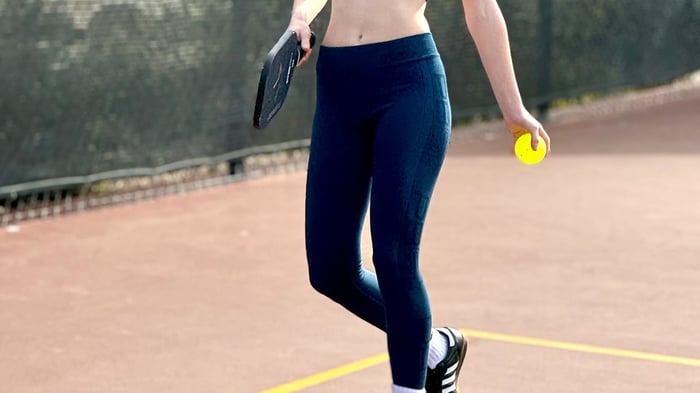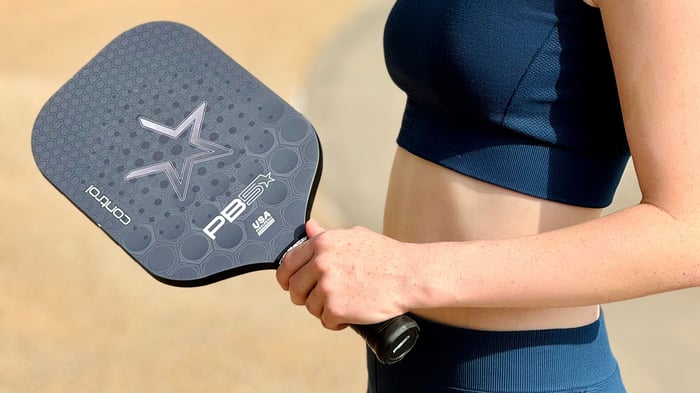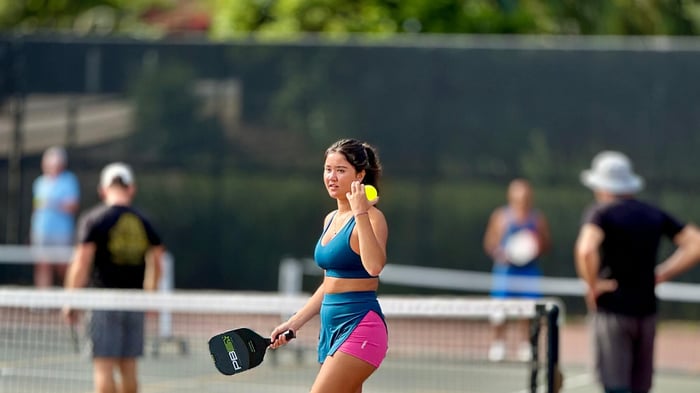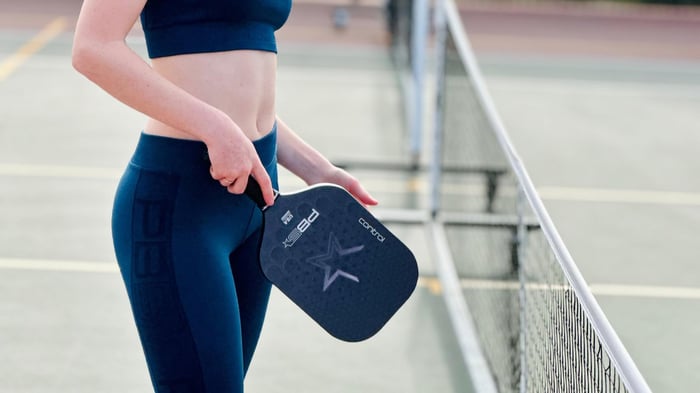Key takeaways:
Mastering the spin serve in pickleball combines artistry, effectiveness, and unique strategies to elevate your game.
There are three main types of spin serves: topspin (causes the ball to dive downward), backspin/underspin (creates a shorter bounce), and sidespin (makes the ball curve left or right after bouncing).
Effective spin generation relies more on wrist action than arm movement, with paddle angle and contact point being crucial factors in creating different spin patterns.
Good news—you can use spin serves, and they're completely legal when done right. The rulebook got some updates in 2023 that eliminated certain extreme spin techniques. Still, standard spin serves remain legal and incredibly effective when you know how to execute them properly.
Many players shy away from developing spin serves because they're confused about the rules or think these techniques belong only in advanced play. In reality, anyone with decent fundamentals can learn effective spin serves that stay within tournament regulations while creating tough returns for opponents. For gear and equipment that can help up your game, check out PB5star.
Pickleball serving rules and spin dynamics
You must serve underhand and hit the ball below your waist. The rules are strict about not adding too much spin when you make contact.
Back in 2023, the rules got an update specifically targeting spin serves. Players used to get creative with pre-serve ball manipulation to create wicked spin, but that's off the table now in tournaments. These days, you have to visibly drop the ball from one hand and hit it clean—no fancy finger tricks to add extra rotation before contact.
The reason a spinning pickleball curves through the air comes down to basic physics. As the ball spins, it creates different air pressures on its sides, which makes it curve during flight. Pickleball pros call this the Magnus effect. Those distinctive holes in pickleballs create unique air patterns that make the spin behave differently than in other sports like tennis or table tennis.
Spin serve fundamentals
A spin serve involves hitting the ball to create rotation, causing unpredictable bounces and trajectories. Unlike straightforward flat serves, spin serves force returners to adjust quickly to altered ball paths. So, can you spin serve in pickleball? The answer is yes and here are the three main types you'll see on the court:
Topspin: The ball spins forward, diving downward after crossing the net. Create this by brushing up the back of the ball with a low-to-high paddle motion. Opponents often scramble as the ball dives toward their feet.
Backspin: Also called underspin, it makes the ball float and bounce shorter than expected. Use a high-to-low paddle motion, brushing under the ball. This is effective against opponents who rush forward too eagerly.
Sidespin: After bouncing, the ball curves sideways, either left or right. Create this by moving your paddle horizontally across the ball. It is perfect for pulling opponents off balance.
While these spins are legal when performed correctly, tournament rules prohibit "enhanced" spin created by manipulating the ball before striking it.
Mastering spin serve techniques
Great spin serves don't happen by accident—they come from paying attention to the details and putting in regular practice time. Those small tweaks in how you hold the paddle or contact the ball make all the difference. Try focusing on these key elements:
A relaxed grip enables the wrist flexibility needed for effective spin generation
For topspin, brush upward on the ball with your paddle face tilted slightly downward
For backspin, brush downward with the paddle face tilted slightly upward
The contact point determines spin effect—hitting different parts of the ball creates different spin patterns
Legal spin relies on wrist action more than arm movement—practice subtle wrist techniques while maintaining stable arm position
Consistent ball drops lead to consistent spins—practice dropping from the same height each time
Begin with slower, controlled motions to develop proper technique before adding power
Varying serves during matches prevents opponents from anticipating and adapting to your patterns
You'll be amazed how quickly these techniques start to feel natural with dedicated practice. Many players see big improvements by devoting 10-15 minutes of each practice session to spin serves. Don't try to master everything at once—consistency beats intensity here.
Strategic applications of spin serves
Smart players use spin serves as tactical weapons to set up the entire point. The right spin serve can put you in control from the very first shot and create immediate advantages. Here's how to strategically deploy different spins against various opponents:
Spin serves to offer tactical advantages beyond making returns difficult. A well-executed spin serve forces opponents out of position, creating opportunities for an aggressive third shot
Topspin works well against players who camp too close to the baseline. That accelerated bounce pushes them backward, often causing awkward returns or positioning errors you can capitalize on
Backspin serves are great against those eager net rushers. The deceptively short, floating bounce disrupts their momentum, typically resulting in weak returns or pop-ups just begging to be attacked
Sidespin serves cause absolute havoc in doubles matches, especially when targeted at the space between players. That unexpected curve creates confusion and communication breakdowns between partners
Reading your opponents' tendencies makes all the difference in which spin to deploy. Players who struggle with low balls are prime targets for backspin, while those big groundstroke hitters often have trouble adjusting to the timing disruption of sidespin serves
Your opponents might figure out one of your tricks, but having multiple spin options means you can always switch tactics mid-match. Watch how your opponents handle different spins early in the game, then exploit the weaknesses you discover when the points really matter.
Common questions about spin serves
Players always have questions about spin serves, from tournament legality to equipment choices. Let's tackle some of the most common ones you might be wondering about as you develop your spin game:
Are spin serves legal in pickleball tournaments?
Basic spin serves are legal in tournaments when you use a natural serving motion. What's not allowed are those "enhanced" spins where players manipulate the ball before hitting it. Tournament refs can spot the difference between skillful spin technique and rule-bending tricks.
How do I counter a spin serve?
Watch the server's paddle angle at contact—it's like a preview of what's coming your way. Try to move early and experiment with taking the ball at different points in its bounce. Keep your paddle grip firm but not death-grip tight, and simplify your return stroke. No need for anything fancy—overswinging against spin usually backfires.
Can beginners effectively use spin serves?
Get comfortable with the basics first. Once you consistently hit your regular serves in the box, start playing with some gentle backspin. Those are the most forgiving for newer players. It is like learning to drive a car—master steering before trying drifting techniques.
Does paddle selection affect spin potential?
Absolutely! Paddles with textured surfaces give you more grip on the ball for better spin. Many tournament players choose their paddles specifically with spin in mind. PB5star’s Balance Paddle features a fiberglass face, offering a good mix of power and control.
How often should I use spin serves in a game?
Mix it up! The best servers keep their opponents guessing. If you use the same spin serve three times in a row, smart players will figure it out by the fourth attempt. Alternate between flat serves, topspin, backspin, and the occasional sidespin to keep your opponents on their toes instead of settling into a groove.
Taking your spin serve to the next level
The verdict on spin serves in pickleball is clear—they're completely legal. Use proper technique rather than those pre-serve ball manipulations that violate the rules. When executed correctly, spin serves give you a real advantage, especially against players who haven't yet figured out how to return them effectively.
Adding topspin, backspin, and sidespin serves to your game'll keep your opponents constantly adjusting. While it takes lots of practice to master these techniques, they add so much dimension and greatly improve your pickleball game. Browse our full selection at PB5star, for equipment that can keep up with you as you improve your pickleball skills.







